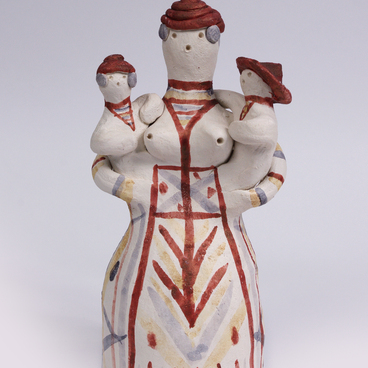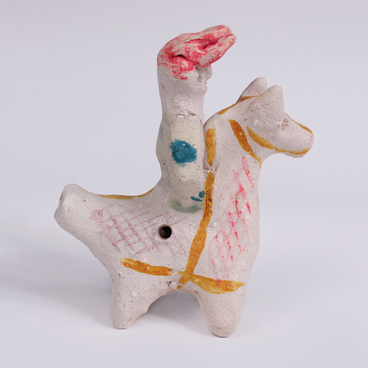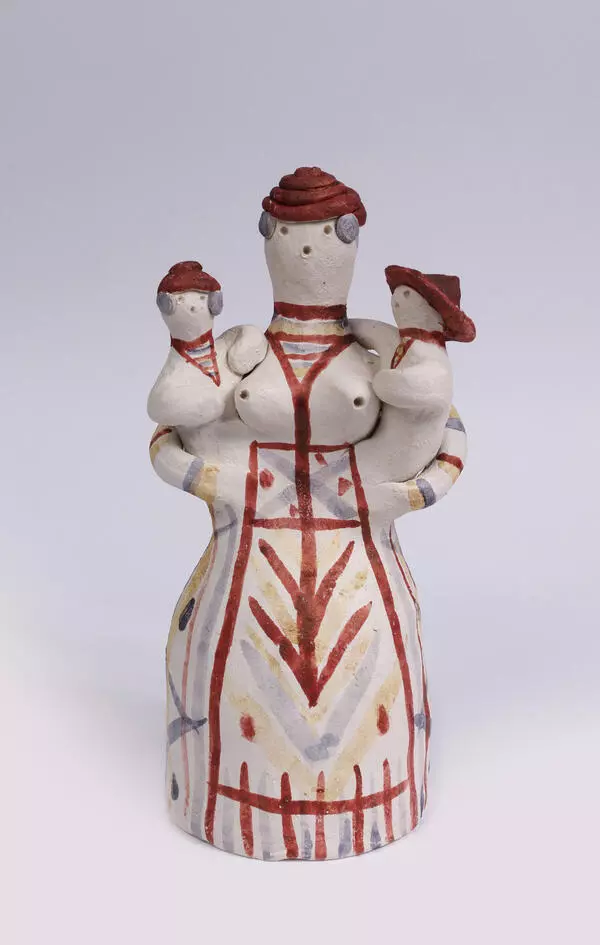This toy was modeled by a Russian craftswoman Natalia Frolova using the knowledge of the craftswomen from the Chernysheno village. In olden times, the cuckoo is one of the most favorite images in these lands. It is associated with traditional beliefs. The bird was venerated as a goddess, a protector of pets. Peasants often said, “Cuckoo, give your note for my livestock!”. Young women read the quaking grass, also known as the cuckoo’s tears, wondering if they were going to have a boy or a girl. They drank the roots portion, chanting the spell, “Cuckoo, send me a little son or daughter.”
This warm attitude towards the bird influenced the craft traditions. All other toys were painted in the “cuckoo” style. Cows, lambs, riders, dolls — all of them were abundantly decorated with alternate stripes that reminded of cuckoo feathers.
A researcher Vasily Glagolev said that Chernysheno toys were modeled without adding water. Usually, the clay was prepared in spring, collected from ravines close to the village. The material was afterward stored in a cellar or other cold places. Before modeling, the clay was broken into pieces with a shovel, then crushed with a wooden block with a handle to make it easier to extract pebbles from the mass. There was no special working tool: twigs, knives, or glass shards were used to cut the base of a toy. Some craftswomen took a pointed peg or an ingot to form dolls' skirts. Usually, they held the toys up the whole time while sculpting and put them on a table or bench only at the end. The craftswomen dried the toys on the tops of the stoves and then fired in a common furnace.
According to the long established tradition, only Chernysheno women were engaged in handicraft. Peasant women did not receive money from their husbands for personal expenses, so they sold dairy products, yarn, canvases, and, of course, toys. Usually, everything was prepared for two fairs — Prepolovenskaya and Troitskaya. It is interesting that the craftswomen called all the figures “whistle horses”, but not “cuckoos”. All whistle horses had very conventional shapes: the craftswomen sculpted them as squatty, with elongated bodies and small legs. The products were also distinct for elongated necks and tiny simplified heads.
This warm attitude towards the bird influenced the craft traditions. All other toys were painted in the “cuckoo” style. Cows, lambs, riders, dolls — all of them were abundantly decorated with alternate stripes that reminded of cuckoo feathers.
A researcher Vasily Glagolev said that Chernysheno toys were modeled without adding water. Usually, the clay was prepared in spring, collected from ravines close to the village. The material was afterward stored in a cellar or other cold places. Before modeling, the clay was broken into pieces with a shovel, then crushed with a wooden block with a handle to make it easier to extract pebbles from the mass. There was no special working tool: twigs, knives, or glass shards were used to cut the base of a toy. Some craftswomen took a pointed peg or an ingot to form dolls' skirts. Usually, they held the toys up the whole time while sculpting and put them on a table or bench only at the end. The craftswomen dried the toys on the tops of the stoves and then fired in a common furnace.
According to the long established tradition, only Chernysheno women were engaged in handicraft. Peasant women did not receive money from their husbands for personal expenses, so they sold dairy products, yarn, canvases, and, of course, toys. Usually, everything was prepared for two fairs — Prepolovenskaya and Troitskaya. It is interesting that the craftswomen called all the figures “whistle horses”, but not “cuckoos”. All whistle horses had very conventional shapes: the craftswomen sculpted them as squatty, with elongated bodies and small legs. The products were also distinct for elongated necks and tiny simplified heads.



